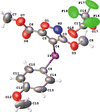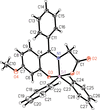issue contents
April 2023 issue

Cover illustration: The binuclear compound {μ-2,2′-(ethane-1,2-diyl)bis[4,6-bis(trimethylsilyl)-1,3-dihydrocyclopenta[c]pyrrol-5-one]}bis[tricarbonyliron(0)], [Fe2(C28H48N2O2Si4)(CO)6], consists of two central iron(0) atoms, each of them surrounded by a cyclopentadienone moiety and three carbonyl ligands in a three-legged piano-stool shape. Furthermore, the bis(cyclopentadienone) ligand acts as a bridge between the two metal atoms. See: Huerta-Zerón, Spannenberg, Beller & Junge [IUCrData (2023). 8, x230346].
metal-organic compounds


 access
access

 access
access

 access
accessorganic compounds


 access
access

 access
access

 access
access

 access
access

 access
access

 access
access

 access
access
 journal menu
journal menu





















![[publCIF]](/logos/authorchecklist11.gif)





